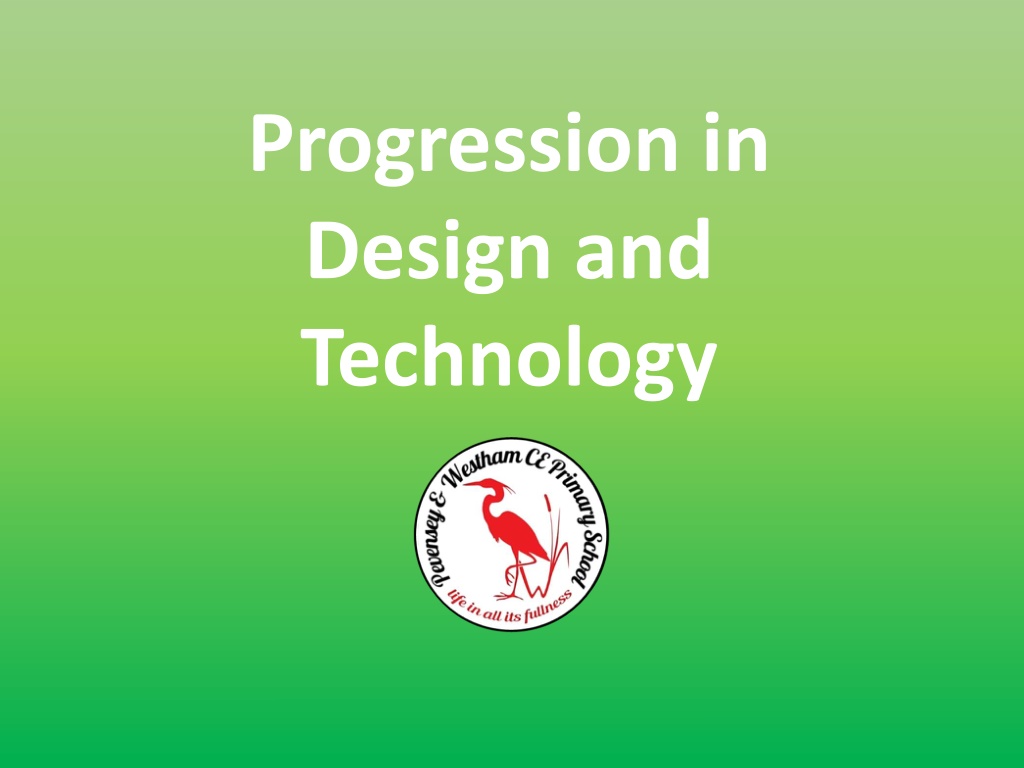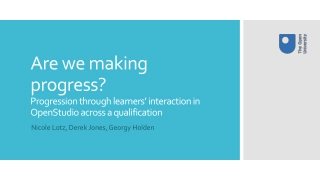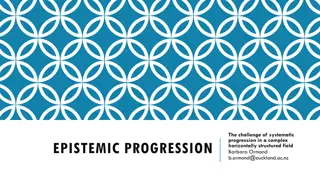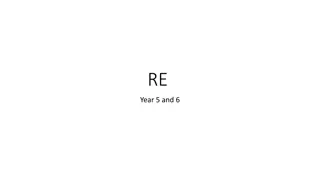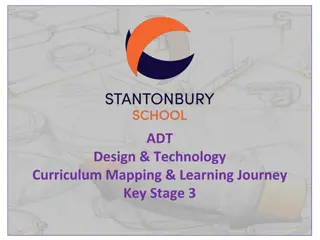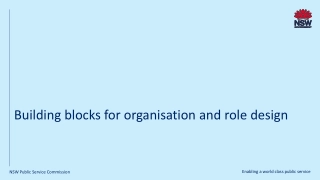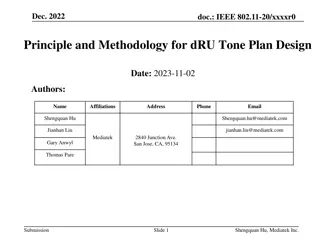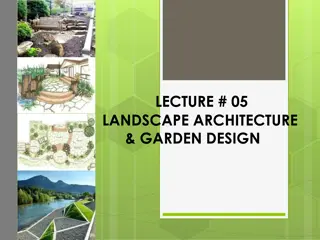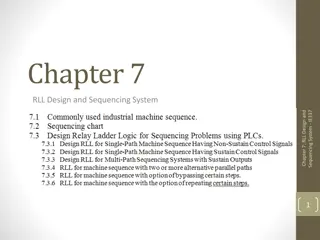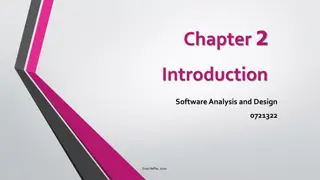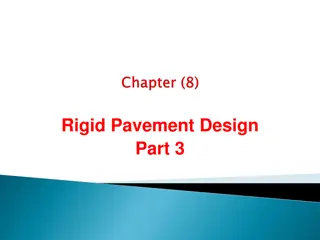Progression in Design and Technology
Designing and Technology curriculum for young students focuses on teaching cooking and nutrition skills through hands-on activities like creating healthy smoothies and wraps. Students learn about fruits, vegetables, food groups, balanced diets, and the importance of nutrients while enhancing their design and creative skills. The curriculum emphasizes safety, hygiene, taste evaluation, packaging design, and building on foundational knowledge from earlier years.
Download Presentation
Please find below an Image/Link to download the presentation.
The content on the website is provided AS IS for your information and personal use only. It may not be sold, licensed, or shared on other websites without obtaining consent from the author. Download presentation by click this link. If you encounter any issues during the download, it is possible that the publisher has removed the file from their server.
Presentation Transcript
Progression in Design and Technology
Cooking and Nutrition
Year 1 Cooking and Nutrition Design a healthy smoothie D&T Skills Chop fruit and vegetables safely Identifying if a food is a fruit or a vegetable Know where and how fruits and vegetables grow Taste and evaluate different food combinations Describe appearance, smell and taste Suggest information to be included on packaging The Design Process End Points of Learning Design developing ideas and planning: Identify the user of a smoothie. Explain what a smoothie is for. Explain through talking how a smoothie will be made. Pupils making a good level of progress will be able to: Chop fruit and vegetables safely Name common fruits and vegetables and sort into fruit or vegetable Describe appearance, smell and taste Design a motif Stitch a pattern using a running stitch Make a product that moves using construction kits with wheels and axles Explain the importance of making sure the axles run freely within the holders. Cut and join materials and components correctly Make: Use a range of tools and equipment. Select from a range of ingredients. Follow procedures for safety and hygiene. Use a range of tools eg knives, blender. combine ingredients Knowledge Know that a fruit has seeds and a vegetable does not Understand that some foods typically known as vegetables are actually fruits (e.g. cucumber) Know that a blender is a machine which mixes ingredients together into a smooth liquid Know that fruits grow on trees or vines Know that vegetables can grow either above or below ground Know that vegetables can come from different parts of the plant (e.g., roots: potatoes, leaves: lettuce, fruit: cucumber) Building on EYFS To recognise different foods as either healthy or unhealthy To know how to use basic cutlery and utensils to make and eat food To follow simple instructions to make different foods To know when we make food for other people that it needs to be appealing Evaluate: Describe how smoothie tastes Explain what they like and dislike about smoothie Spotlight on SEND In line with our school policy, we ensure inclusion using our Learning Principles to review and scaffold learning as well as constructing enquiries which are graduated in bite size steps allowing for the setting of personalised targets, a broad range of learning and teaching strategies including questioning, working with additional adults where appropriate and a holistic approach to assessing achievement. Planning Resources KAPOW planning on network
Year 2 Cooking and Nutrition Design and prepare a healthy wrap for a snack D&T Skills Slice food safely using the bridge or claw grip Evaluating which grip was most effective Construct a wrap that meets a design brief Describe the taste, texture and smell of fruit and vegetables Taste test food combinations and final products Describe the information that should be included on a label Knowledge Know that diet means the food and drink that a person or animal usually eats Understand what makes a balanced diet Know where to find the nutritional information on packaging Know that the five main food groups are: Carbohydrates, fruits and vegetables, protein, dairy and foods high in fat and sugar Understand that I should eat a range of different foods from each food group, and roughly how much of each food group Know that nutrients are substances in food that all living things need to make energy, grow and develop Know that I should only have a maximum of five teaspoons of sugar a day to stay healthy Know that many food and drinks we do not expect to contain sugar do; we call these hidden sugars Building on Year 1 Chop fruit and vegetables safely Name common fruits and vegetables and sort into fruit or vegetable Describe appearance, smell and taste The Design Process End Points of Learning Design developing ideas and planning: Describe how they will make their products suitable for their intended users Use simple design criteria to help develop their ideas Generate ideas by drawing on their own experiences Use knowledge of existing products to help design an appealing healthy wrap Pupils making a good level of progress will be able to: Slice safely using bridge and claw grip Create an appealing looking food which meets design brief Describe the taste, texture and smell Select, mark out, cut and join fabric pieces. Cut neatly and use neat, even running stitch Add finishing features Communicate their ideas through talking and drawing Measure, mark out, cut and shape materials and components Assemble with increasing independence Evaluate finished product and suggest improvements Make: Select from a range of ingredients explaining their choices Measure and cut ingredients safely Combine ingredients with increasing independence Create an appealing looking finished wrap Evaluate: Make simple judgements about their wrap and ideas against design criteria Suggest how their wrap could be improved Spotlight on SEND In line with our school policy, we ensure inclusion using our Learning Principles to review and scaffold learning as well as constructing enquiries which are graduated in bite size steps allowing for the setting of personalised targets, a broad range of learning and teaching strategies including questioning, working with additional adults where appropriate and a holistic approach to assessing achievement. Planning Resources KAPOW planning on network
Year 3 Cooking and Nutrition Design and prepare a salad school lunch Skills Know how to prepare themselves and a work space to cook safely in, learning the basic rules to avoid food contamination Follow the instructions within a recipe Establish and use design criteria to help test and review dishes Describe the benefits of seasonal fruits and vegetables and the impact on the environment D&T The Design Process Design developing ideas and planning: Explore where different foods come from in the world Model and follow Japanese fruit skewers with plum sauce recipe Explore the term food miles and the effects of importing food. Introduce design brief Select own ingredients End Points of Learning Pupils making a good level of progress will be able to: Prepare a safe work space including following rules to avoid food contamination Follow a recipe Describe health benefits of seasonal fruits and vegetable Understand the negative affects of imported foods Select, measure and mark out materials and components Cut neatly and accurately Use neat running and back stitch Add detailed finishing design features Join materials using appropriate methods Identify strengths and areas for development Knowledge Know that cooking instructions are known as a recipe Know safety rules for using, storing and cleaning a knife safely Know that not all fruits and vegetables can be grown in the UK Know that climate affects food growth Know that vegetables and fruit grow in certain seasons Know that imported food is food which has been brought into the country Know that exported food is food which has been sent to another country. Understand that imported foods travel from far away and this can negatively impact the environment Understand that vitamins, minerals and fibre are important for energy, growth and maintaining health Know that similar coloured fruits and vegetables often have similar nutritional benefits Create an appealing looking food which meets design brief Describe the taste, texture and smell Communicate their ideas through talking and drawing Make: Safely follow a recipe when cooking Select ingredients, equipment and tools suitable for the task With increasing accuracy, measure,, cut and combine ingredients Review hygiene and health & safety considerations when cooking Understand that our ideas will not always work as planned Evaluate: Evaluate finished produce against design brief Identify the strengths and areas for development in their ideas Evaluate positive effect that eating seasonal Spotlight on SEND fruit and vegetables has on the environment. Building on Year 2 Slice safely using bridge and claw grip In line with our school policy, we ensure inclusion using our Learning Principles to review and scaffold learning as well as constructing enquiries which are graduated in bite size steps allowing for the setting of personalised targets, a broad range of learning and teaching strategies including questioning, working with additional adults where appropriate and a holistic approach to assessing achievement. Planning Resources KAPOW planning on network
Year 4 Cooking and Nutrition To adapt a biscuit recipe D&T End Points of Learning Skills Follow a baking recipe Cook safely, following basic hygiene rules Adapt a recipe Evaluate a recipe, considering: taste, smell, texture and appearance Describe the impact of the budget on the selection of ingredients Evaluate and compare a range of products Suggest modifications The Design Process Pupils making a good level of progress will be able to: Work safety with a range of tools and hygienically Adapt a recipe Evaluate and compare based on taste, smell, texture and appearance Plan and make a product within a given budget Select appropriate stitches for strength Use neat, consistently sized stitches Measure, mark out, cut and shape materials and components with some accuracy Assemble, join and combine materials and components with some accuracy Use annotated sketches and cross-sectional drawings communicate ideas. Consider the views of others, including intended users, to improve their work Design developing ideas and planning: Introduce design brief Follow simple recipe Modify a recipe and make a simple prototype Design final recipe within budget Make: Children to follow same basic recipe, adding their own ingredients to modify the recipe In groups, children will make one batch of their final recipe Use different food preparation techniques: sieving, creaming, rubbing method, cooling Create packaging Begin to show resilience and adapt work when original ideas do not work. Knowledge Know that the amount of an ingredient in a recipe is known as the quantity Know that it is important to use oven gloves when removing hot food from an oven Know the following cooking techniques: sieving, creaming, rubbing method, cooling Understand the importance of budgeting while planning ingredients for biscuits Evaluate: Present product to panel of judges Evaluate final product against design brief Building on Year 3 Prepare a safe work space including following rules to avoid food contamination Follow a recipe Describe health benefits of seasonal fruits and vegetable Understand the negative affects of imported foods Identify strengths and areas for development Spotlight on SEND In line with our school policy, we ensure inclusion using our Learning Principles to review and scaffold learning as well as constructing enquiries which are graduated in bite size steps allowing for the setting of personalised targets, a broad range of learning and teaching strategies including questioning, working with additional adults where appropriate and a holistic approach to assessing achievement. Planning Resources KAPOW planning on network
Year 5 Cooking and Nutrition Make a bolognaise sauce for children that is full of favour, palatable for fussy eaters and healthy? Skills Cut and prepare vegetables safely and with increasing confidence Use equipment safely, including knives, hot pans and hobs Know how to avoid cross-contamination Follow a step-by-step method carefully to make a recipe Identify the nutritional differences between different products and recipes Identify and describe healthy benefits of food groups Formulate step-by-step recipe as a guide to making Select appropriate tools and ingredients Measure and combine ingredients accurately Demonstrate resilience and adapt work when original ideas do not work. healthier by substituting ingredients Know that I can use a nutritional calculator to see how healthy a food option is Understand that cross-contamination means that bacteria and germs have been passed onto ready-to-eat foods and it happens when these foods mix with raw meat or unclean objects D&T The Design Process End Points of Learning Design developing ideas and planning: Explore ingredients in a spaghetti bolognaise Explore where the ingredients come from Children recognise the nutritional differences between different products and recipes. Introduce design brief children to create an tasty, innovative and healthy bolognaise sauce Design appealing and nutritious recipe Pupils making a good level of progress will be able to: Use equipment safely and hygienically Identify and describe healthy benefits of different food groups Explore and evaluate a range of existing products Select ingredients for flavour and nutritional values Sew a running and back stitch with increasing neatness Sew a blanket stitch Use a pattern/ template to design Accurately measure, mark out, cut and shape materials and components Accurately assemble, join and combine materials and components Use annotated sketches cross-sectional drawings and exploded diagrams to communicate ideas. Evaluate critically both the appearance and function against the original specifications Make: Knowledge Understand where meat comes from - learning that beef is from cattle and how beef is reared and processed, including key welfare issues Know that I can adapt a recipe to make it Evaluate: Evaluate their ideas and products against their original design brief Evaluate how nutritious final product is Building on Year 4 Work safety with a range of tools and hygienically Adapt a recipe Evaluate and compare based on taste, smell, texture and appearance Plan and make a product within a given budget Consider the views of others, including intended users, to improve their work Spotlight on SEND In line with our school policy, we ensure inclusion using our Learning Principles to review and scaffold learning as well as constructing enquiries which are graduated in bite size steps allowing for the setting of personalised targets, a broad range of learning and teaching strategies including questioning, working with additional adults where appropriate and a holistic approach to assessing achievement. Planning Resources KAPOW planning on network
Year 6 Design Brief: To design and make a soup for a World War Two Tea Party D&T Skills Follow a recipe, including using the correct quantities of each ingredient Adapt a recipe based on research Work to a given timescale Work safely and hygienically with independence Evaluate a recipe, considering: taste, smell, texture and origin of the food group Taste test and score final products Suggest and write up points of improvements in productions Evaluate health and safety in production to minimise cross contamination The Design Process End Points of Learning Design developing ideas and planning: Evaluate a range of existing products Identify differences between potential ingredients Select from available ingredients and write own recipes, considering taste, healthiness and dietary requirements Pupils making a good level of progress will be able to: Work safely and hygienically Adapt a recipe considering taste, healthiness and available ingredients Select stitches appropriate to task Use a pattern Measure and cut fabric accurately Join fabric with strong, consistent, neat stitches Add finishing details e.g. pocket, initials, decorative detail Generate innovative ideas drawing on research Use an electrical system in their produce Make improvements and adapt ideas during making process Critically evaluate finished product Make: Select appropriately from range of tools Select and use appropriate cutting techniques Work safely and hygienically Follow won written recipe Demonstrate resourcefulness and resilience when planning improvements Knowledge Know that flavour is how a food or drink tastes Know that many countries have national dishes which are recipes associated with that country Know that processed food means food that has been put through multiple changes in a factory Understand that it is important to wash fruit and vegetables before eating to remove any dirt and insecticides Understand what happens to a certain food before it appears on the supermarket shelf (Farm to Fork) Building on Year 5 Use equipment safely and hygienically Identify and describe healthy benefits of different food groups Explore and evaluate a range of existing products Select ingredients for flavour and nutritional values Evaluate critically both the appearance and function against the original specifications Evaluate: Critically evaluate the quality of the design, manufacture and fitness for purpose of their products as they design and make. Consider views/ feedback of guests at World War Two tea party Spotlight on SEND In line with our school policy, we ensure inclusion using our Learning Principles to review and scaffold learning as well as constructing enquiries which are graduated in bite size steps allowing for the setting of personalised targets, a broad range of learning and teaching strategies including questioning, working with additional adults where appropriate and a holistic approach to assessing achievement. Planning Resources Year group planning on network
Year 1 Textiles: To design and sew a pattern for a greeting card D&T Skills With support, begin to thread a needle independently With support, tie a knot or overstitch to secure thread Can use a running stitch in binca With support, can start to use a The Design Process End Points of Learning Design developing ideas and planning: Make clear, labelled drawings of the card motif Design a card for a purpose Pupils making a good level of progress will be able to: Chop fruit and vegetables safely Name common fruits and vegetables and sort into fruit or vegetable Describe appearance, smell and taste Design a motif Stitch a pattern using a running stitch Make a product that moves using construction kits with wheels and axles Explain the importance of making sure the axles run freely within the holders. Cut and join materials and components correctly Make: Practise basic sewing techniques eg starting, ending, running stitch Count and use stitches to create motif Use different colour thread for effect backstitch in binca Can loop thread back through to end stitching Evaluate: Evaluate against the design criteria. Evaluate quality of finished card Knowledge Recognize and name different types of textiles/fabric e.g., felt, velvet, cotton. Can name a needle, stitch, thread, binca Knows what a running stitch is. Understand: strong, quality, features, strengthen, position, to, towards Spotlight on SEND In line with our school policy, we ensure inclusion using our Learning Principles to review and scaffold learning as well as constructing enquiries which are graduated in bite size steps allowing for the setting of personalised targets, a broad range of learning and teaching strategies including questioning, working with additional adults where appropriate and a holistic approach to assessing achievement. Building on EYFS To talk about what materials they are going to use when making / building / constructing To join materials together when making / building / constructing To build / construct structures from a range of materials to a design brief that they have created or been given. To know that tape and glue can join materials together and can make structures stronger. Planning Resources
Year 2 Textiles: To design a Christmas tree decoration to display on a Christmas tree at St Mary s Church D&T Skills With increasing independence, thread a needle Stitch two pieces of fabric using a running stitch. Select from and use a range of tools and equipment to perform practical tasks such as marking out, cutting, joining and finishing. Select from and use textiles according to their characteristics. Understand how to join fabrics using different techniques e.g., running stitch, glue, over stitch, stapling. Explore and attach different finishing techniques e.g. using painting, fabric crayons, stitching, sequins, buttons and ribbons. The Design Process End Points of Learning Design developing ideas and planning: Investigate and evaluate a range of existing textile tree decorations Explore and compare e.g. fabrics, joining techniques, finishing techniques Design a fabric tree decoration to hang on a Christmas tree Pupils making a good level of progress will be able to: Slice safely using bridge and claw grip Create an appealing looking food which meets design brief Describe the taste, texture and smell Select, mark out, cut and join fabric pieces. Cut neatly and use neat, even running stitch Add finishing features Communicate their ideas through talking and drawing Measure, mark out, cut and shape materials and components Assemble with increasing independence Evaluate finished product and suggest improvements Make Select from and use textiles according to their characteristics. select from and use a range of tools and equipment to perform practical tasks such as marking out, cutting, joining and finishing. use neat, even running stitch to join use stuffing to add 3D shape, before finishing stitching select and add finishing techniques and ribbon to hang Knowledge Know the skills needed for threading a needle Knows what a running stitch is. Evaluate: Evaluate their ideas throughout and their final products against original design criteria Suggest how their product could be improved Know that some joining techniques are stronger/weaker than others Spotlight on SEND Building on Year 1 Design a motif Stitch a pattern using a running stitch In line with our school policy, we ensure inclusion using our Learning Principles to review and scaffold learning as well as constructing enquiries which are graduated in bite size steps allowing for the setting of personalised targets, a broad range of learning and teaching strategies including questioning, working with additional adults where appropriate and a holistic approach to assessing achievement. Planning Resources
Year 3 Textiles: To make a hand puppet to tell a story D&T Skills Thread a needle independently. Use a running stitch and a back stitch independently. Understand how to securely join two pieces of fabric together. Understand how simple 3-D textile products are made, using a template to create two identical shapes. Understand the need for patterns and seam allowances. Apply decoration using beads, buttons, feathers etc. considering the aesthetics The Design Process Design developing ideas and planning: Investigate a range of textile products that have a selection of stitches, joins, fabrics, finishing techniques, fastenings and purposes, linked to the product they will design, make and evaluate. Disassemble appropriate textiles products to gain an understanding of 3-D shape, patterns and seam allowances, different fabrics Recap running stitch, teach and practice backstitch Discuss the intended user, purpose and appeal of their product. Create a set of design criteria. Make Select and use a range of appropriate tools with some accuracy e.g. cutting, joining and finishing. Select stitches, fabrics and fastenings according to their functional characteristics e.g. strength, and aesthetic qualities e.g. pattern use neat, even stitches to join select and add finishing techniques e.g. use backstitch to add detail/ design e.g. initials use stuffing to add 3D shape Evaluate: . Test their product against the original design criteria and with the intended user. Take into account others views. End Points of Learning Pupils making a good level of progress will be able to: Prepare a safe work space including following rules to avoid food contamination Follow a recipe Describe health benefits of seasonal fruits and vegetable Understand the negative affects of imported foods Select, measure and mark out materials and components Cut neatly and accurately Use neat running and back stitch Add detailed finishing design features Join materials using appropriate methods Identify strengths and areas for development Knowledge Know what a back stitch is. Knows that a back stitch is stronger than a running stitch Building on Year 2 Select, mark out, cut and join fabric pieces. Cut neatly and use neat, even running stitch Add finishing features Communicate their ideas through talking and drawing Evaluate finished product and suggest improvements Spotlight on SEND In line with our school policy, we ensure inclusion using our Learning Principles to review and scaffold learning as well as constructing enquiries which are graduated in bite size steps allowing for the setting of personalised targets, a broad range of learning and teaching strategies including questioning, working with additional adults where appropriate and a holistic approach to assessing achievement. Planning Resources
Year 4 Textiles: Design and make a bendy bag to store a chosen item Skills Thread a needle and tie a knot independently. Use a running and back stitch with increasing consistency Understand the need for strong, even stitches and seam allowances. Know how to strengthen, stiffen and reinforce existing fabrics. Apply decoration using needle and thread: buttons, sequins. Use decorative techniques e.g., appliqu , embroidery or fabric paints considering the aesthetics Make Produce drawings with labels to show what they intend to make and the sequence of their work Order the sequence of their work Select from given range of tools, equipment, materials and components Construct their bendy bag with some accuracy, selecting appropriate strong stitches Building on Year 3 Prepare a safe work space Select, measure and mark out materials and components Cut neatly and accurately Use neat running and back stitch Add detailed finishing design features Identify strengths and areas for development D&T The Design Process End Points of Learning Design developing ideas and planning: Examine carefully a collection of simple textile containers e.g. purses, wallets, spectacle cases, draw string bags. Focus the children s attention on the seams and seam allowance, size, fitness for purpose Use simple paper bags to create a prototype. Investigate plastic strips and their flexible properties. Decide the purpose and user of the bendy bag - draw up a simple design specification stating clearly what will be kept in the bag Pupils making a good level of progress will be able to: Work safety with a range of tools and hygienically Adapt a recipe Evaluate and compare based on taste, smell, texture and appearance Plan and make a product within a given budget Select appropriate stitches for strength Use neat, consistently sized stitches Measure, mark out, cut and shape materials and components with some accuracy Assemble, join and combine materials and components with some accuracy Use annotated sketches and cross-sectional drawings communicate ideas. Consider the views of others, including intended users, to improve their work Knowledge Know that plastic can be flexible Understand that joining needs to be secure and strong Evaluate: Evaluate the finished bags by testing in use, discussing strengths and areas for development of both appearance and function suggesting Spotlight on SEND improvements. Take into account others views. In line with our school policy, we ensure inclusion using our Learning Principles to review and scaffold learning as well as constructing enquiries which are graduated in bite size steps allowing for the setting of personalised targets, a broad range of learning and teaching strategies including questioning, working with additional adults where appropriate and a holistic approach to assessing achievement. Planning Resources
Year 5 Textiles: To design and make a bag to store wash kit at camp Skills The Design Process Design developing ideas and planning: Research and develop design criteria to inform design evaluate bags considering appearance, function, cost and safety, functional and decorative products; Generate, model and communicate ideas through discussion, sketches and pattern pieces, Create working drawing and pattern of the chosen idea, including measurements, stitch types and fabric swatches. to make a bag. D&T End Points of Learning Continue to use a running stitch and back stitch and select appropriate stitch for strength. Pupils making a good level of progress will be able to: Use equipment safely and hygienically Identify and describe healthy benefits of different food groups Explore and evaluate a range of existing products Select ingredients for flavour and nutritional values Sew a running and back stitch with increasing neatness Sew a blanket stitch Use a pattern/ template to design Accurately measure, mark out, cut and shape materials and components Accurately assemble, join and combine materials and components Use annotated sketches cross-sectional drawings and exploded diagrams to communicate ideas. Evaluate critically both the appearance and function against the original specifications Introduce a blanket stitch Use a pattern/template in designing a product. Pin, sew and stitch materials together to create a product; To allow for seam allowance Sew casing for and thread cord. Knowledge Understand that a pattern/template ca be used Make Know that when using a pattern, you need to make allowances for the seam. Select from and use a wider range of tools, equipment, materials and components Make a prototype for their bag, allowing for seam allowances of 1 1.5cm (plain paper or grid paper can be used). And larger top seam for drawstring Pin the pattern onto the fabric allowing minimal wastage Cut and join material using appropriate stitches Add cord for drawstring Add decorative detail, considering aesthetic quality Knows what a blanket stitch is. Knows that a blanket stitch be used to hold two edges together, to neaten edges or to produce a decorative effect. Building on Year 4 Work safety with a range of tools Select appropriate stitches for strength Use neat, consistently sized stitches Measure, mark out, cut and shape materials and components with some accuracy Assemble, join and combine materials and components with some accuracy Use annotated sketches and cross-sectional drawings communicate ideas. Consider the views of others, including intended users, to improve their work Spotlight on SEND Evaluate: Evaluate bag against the design specification (including user testing). What do the users think of the bags? Do they meet their needs well? How could they be made better? What would you change? What are you pleased with? In line with our school policy, we ensure inclusion using our Learning Principles to review and scaffold learning as well as constructing enquiries which are graduated in bite size steps allowing for the setting of personalised targets, a broad range of learning and teaching strategies including questioning, working with additional adults where appropriate and a holistic approach to assessing achievement. Planning Resources
Year 6 textiles: To make an apron to wear for our World War Two tea party The Design Process Design developing ideas and planning: Generate and develop innovative ideas by carrying out research including evaluating existing products, surveys, interviews Develop, model and communicate ideas through discussion, drawing, templates, mock-ups and prototypes and, where appropriate, computer- aided design. Design purposeful, functional, appealing products for the intended user that are fit for purpose based on a simple design specification. D&T Skills End Points of Learning Use a range of stitches creatively, selecting the most appropriate to specific task, e.g., consider strength/aesthetics Develop skills of sewing textiles by joining right side together and making seams. Start and finish off a row of stitches. Pin a pattern on to fabric ensuring limited wastage Know to leave a seam allowance and different cutting techniques. Experiment with a variety of techniques. Recognise different forms of textiles and express opinions on them. Knowledge Understand how a 3-D textile product can be made from a combination of accurately made pattern pieces, fabric shapes and different fabrics. Know that fabrics can be strengthened, stiffened and reinforced where appropriate. Pupils making a good level of progress will be able to: Work safely and hygienically Adapt a recipe considering taste, healthiness and available ingredients Select stitches appropriate to task Use a pattern Measure and cut fabric accurately Join fabric with strong, consistent, neat stitches Add finishing details e.g. pocket, initials, decorative detail Generate innovative ideas drawing on research Use an electrical system in their produce Make improvements and adapt ideas during making process Critically evaluate finished product Make Produce detailed lists of equipment and fabrics relevant to their tasks. Formulate step-by-step plans Select from and use a range of tools and equipment to make products that are accurately assembled and well finished. Work within the constraints of time, resources and cost. Evaluate: Investigate and analyse textile products linked to their final product. Compare the final product to the original design specification. Test products with intended user and critically evaluate the quality of the design, manufacture, functionality and fitness for purpose. Consider the views of others to improve their work Building on Year 5 Use equipment safely Sew a running and back stitch with increasing neatness Sew a blanket stitch Use a pattern/ template to design Accurately measure, mark out, cut and shape materials and components Accurately assemble, join and combine materials and components Use annotated sketches cross-sectional drawings and exploded diagrams to communicate ideas. Evaluate critically both the appearance and function against the original specifications Spotlight on SEND In line with our school policy, we ensure inclusion using our Learning Principles to review and scaffold learning as well as constructing enquiries which are graduated in bite size steps allowing for the setting of personalised targets, a broad range of learning and teaching strategies including questioning, working with additional adults where appropriate and a holistic approach to assessing achievement. Planning Resources
Year 1 Wheels and Axels Design and create a moving vehicle (moon buggy) Skills Using construction kits with wheels and axles Investigate and understand how parts are put together in order to make a moving vehicle Recognise the importance of correct position of wheels and axels in making a vehicle run smoothly Test and evaluate the vehicle considering purpose and suitability Make: Select from and use a range of tools and Knowledge Understand that wheels and axels can be assembled in different ways Distinguish between fixed and freely moving axles D&T The Design Process End Points of Learning Design developing ideas and planning: Identify the user of a product. Explain what a product is for. Generate initial ideas and simple design criteria through talking and using own experiences. Develop and communicate ideas through drawings and mock-ups. Pupils making a good level of progress will be able to: Chop fruit and vegetables safely Name common fruits and vegetables and sort into fruit or vegetable Describe appearance, smell and taste Design a motif Stitch a pattern using a running stitch Make a product that moves using construction kits with wheels and axles Explain the importance of making sure the axles run freely within the holders. Cut and join materials and components correctly equipment to perform practical tasks such as cutting and joining to allow movement and finishing. Select from and use a range of materials and components such as paper, card, plastic and wood according to their characteristics. Evaluate: Explore and evaluate a range of products with wheels and axles. Evaluate their ideas throughout and their products against original criteria. Explain what they like and dislike about products Building on EYFS To describe something they want to make / build / construct To say who they are making / building / constructing for Spotlight on SEND To talk about what materials they are going to use when making / building / constructing In line with our school policy, we ensure inclusion using our Learning Principles to review and scaffold learning as well as constructing enquiries which are graduated in bite size steps allowing for the setting of personalised targets, a broad range of learning and teaching strategies including questioning, working with additional adults where appropriate and a holistic approach to assessing achievement. To make / build / construct objects using a variety of materials To join materials together when making / building / constructing Planning Resources To know that tape and glue can join materials together and can make structures stronger. D&T Association Planning on a Page
Year 2 Freestanding structures Design and make a bug house D&T Skills Identify similarities and differences in free standing structures. Experiment with different assembly techniques for strength and stability. Know how to make freestanding structures stronger, stiffer and more stable. The Design Process Design developing ideas and planning: Describe how they will make their products suitable for their intended users Generate ideas based on simple design criteria and their own experiences, explaining what they could make. Develop, model and communicate their ideas through talking, mock-ups and drawings. End Points of Learning Pupils making a good level of progress will be able to: Slice safely using bridge and claw grip Create an appealing looking food which meets design brief Describe the taste, texture and smell Select, mark out, cut and join fabric pieces. Cut neatly and use neat, even running stitch Add finishing features Communicate their ideas through talking and drawing Measure, mark out, cut and shape materials and components Assemble with increasing independence Evaluate finished product and suggest improvements Make: Select from a range of materials explaining their choices Select from a range of tools Measure, mark out, cut and shape materials and components Assemble, join and combine materials and components with increasing independence Use finishing techniques, select from a range of tools Knowledge Identify free standing structures and explain how they know they are freestanding Building on Year 1 Make a product that moves using construction kits with wheels and axles Explain the importance of making sure the axles run freely within the holders. Cut and join materials and components correctly Evaluate: Make simple judgements about their products and ideas against design criteria Suggest how their products could be improved Spotlight on SEND In line with our school policy, we ensure inclusion using our Learning Principles to review and scaffold learning as well as constructing enquiries which are graduated in bite size steps allowing for the setting of personalised targets, a broad range of learning and teaching strategies including questioning, working with additional adults where appropriate and a holistic approach to assessing achievement. Planning Resources D&T Association Planning on a Page
Year 3 Shell Structures To design and make a pencil pot for a family member D&T Skills Evaluate a range of shell structures identifying their purpose and intended user Explain how materials have been stiffened. Develop and use knowledge of nets of cubes and cuboids and, where appropriate, more complex 3D shapes structures Create a shell structure to protect another product Demonstrate how to use different ways of stiffening and strengthening their shell structures e.g., folding and shaping, corrugating, ribbing, laminating. Knowledge Know that shell structures are hollow shapes made from nets. Know that there are a range of shell structure products which have been designed, produced and evaluated. Understand that shell structures can be made of different materials. Recognise that shell structures can present, protect or contain another product. The Design Process Design developing ideas and planning: Generate realistic ideas, focusing on the needs of the user Explain how particular parts of their products will work Share and clarify ideas through discussion Use annotated sketches to communicate their ideas Use computer-aided design to develop and communicate their ideas End Points of Learning Pupils making a good level of progress will be able to: Prepare a safe work space including following rules to avoid food contamination Follow a recipe Describe health benefits of seasonal fruits and vegetable Understand the negative affects of imported foods Select, measure and mark out materials and components Cut neatly and accurately Use neat running and back stitch Add detailed finishing design features Join materials using appropriate methods Identify strengths and areas for development Make: Order the main stages of making Select materials, equipment and tools equipment suitable for the task With increasing accuracy, measure, mark out, cut and shape materials and components Join materials together using the best method for the material Explain their choice of materials and components according to functional properties and aesthetic qualities Understand that our ideas will not always work as planned Evaluate: Refer to their design criteria as they design and make Building on Year 2 Communicate their ideas through talking and drawing Measure, mark out, cut and shape materials and components Assemble with increasing independence Evaluate finished product and suggest improvements Spotlight on SEND Identify the strengths and areas for development in their ideas and products In line with our school policy, we ensure inclusion using our Learning Principles to review and scaffold learning as well as constructing enquiries which are graduated in bite size steps allowing for the setting of personalised targets, a broad range of learning and teaching strategies including questioning, working with additional adults where appropriate and a holistic approach to assessing achievement. Planning Resources D&T Association Planning on a Page
Year 4 Pneumatics Design and create a pneumatic toy for a KS1 child D&T End Points of Learning Skills Demonstrate how to assemble the systems using syringes, tubing, balloons and plastic bottles Understand and use pneumatic mechanisms. The Design Process Design developing ideas and planning: Indicate the design features of their products that will appeal to intended users Gather information about the needs and wants of particular individuals and groups Use annotated sketches and cross-sectional drawings communicate ideas. Make design decisions within a set budget Pupils making a good level of progress will be able to: Work safety with a range of tools and hygienically Adapt a recipe Evaluate and compare based on taste, smell, texture and appearance Plan and make a product within a given budget Select appropriate stitches for strength Use neat, consistently sized stitches Measure, mark out, cut and shape materials and components with some accuracy Assemble, join and combine materials and components with some accuracy Use annotated sketches and cross-sectional drawings communicate ideas. Consider the views of others, including intended users, to improve their work Make: Measure, mark out, cut and shape materials and components with some accuracy Assemble, join and combine materials and components with some accuracy Apply a range of finishing techniques, including those from art and design, with some Begin to show resilience and adapt work when original ideas do not work. Knowledge Identify the use of pneumatics in real world contexts Evaluate: Consider the views of others, including intended users, to improve their work Use their design criteria to evaluate their completed products Building on Year 3 Select, measure and mark out materials and components Cut neatly and accurately Join materials using appropriate methods Identify strengths and areas for development Spotlight on SEND In line with our school policy, we ensure inclusion using our Learning Principles to review and scaffold learning as well as constructing enquiries which are graduated in bite size steps allowing for the setting of personalised targets, a broad range of learning and teaching strategies including questioning, working with additional adults where appropriate and a holistic approach to assessing achievement. Planning Resources D&T Association Planning on a Page
Year 5 Design a bridge for students at PaWS to cross the railway line to reduce the number of pupils who are late D&T Skills Evaluate a range of frame structures including towers, bridges, buildings, etc. Identifying how the structures have been made and how materials have been stiffened and strengthened Design a frame structure product for an intended user and purpose The Design Process Design developing ideas and planning: Identify the needs, wants, preferences and values of particular individuals and groups Model their ideas using prototypes and pattern pieces Use annotated sketches, cross-sectional drawings and exploded diagrams to communicate ideas. End Points of Learning Pupils making a good level of progress will be able to: Use equipment safely and hygienically Identify and describe healthy benefits of different food groups Explore and evaluate a range of existing products Select ingredients for flavour and nutritional values Sew a running and back stitch with increasing neatness Sew a blanket stitch Use a pattern/ template to design Accurately measure, mark out, cut and shape materials and components Accurately assemble, join and combine materials and components Use annotated sketches cross-sectional drawings and exploded diagrams to communicate ideas. Evaluate critically both the appearance and function against the original specifications Make: Produce appropriate lists of tools, equipment and materials that they need Formulate step-by-step plans as a guide to making Accurately measure, mark out, cut and shape materials and components Accurately assemble, join and combine materials and components Demonstrate resilience and adapt work when original ideas do not work. Knowledge Identify a range of frame structures Know the names and buildings associated with established architects. Building on Year 4 Work safety with a range of tools Select appropriate stitches for strength Use neat, consistently sized stitches Measure, mark out, cut and shape materials and components with some accuracy Assemble, join and combine materials and components with some accuracy Use annotated sketches and cross-sectional drawings communicate ideas. Consider the views of others, including intended users, to improve their work Evaluate: Evaluate their ideas and products against their original design specification Consider how innovative products are Evaluate how sustainable the materials in products are Spotlight on SEND In line with our school policy, we ensure inclusion using our Learning Principles to review and scaffold learning as well as constructing enquiries which are graduated in bite size steps allowing for the setting of personalised targets, a broad range of learning and teaching strategies including questioning, working with additional adults where appropriate and a holistic approach to assessing achievement. Planning Resources D&T Association Planning on a Page
Year 6 Switches and circuits To make an alarm to protect the school vegetable patch D&T Skills Evaluate electrical products that respond to changes in the environment using a computer control program. Design and make an electrical product for an intended user and purpose Use a computer control program to control The Design Process End Points of Learning Design developing ideas and planning: Carry out research, using surveys, interviews, questionnaires and web-based resources Generate innovative ideas, drawing on research Make design decisions, taking account of constraints such as time, resources and cost Pupils making a good level of progress will be able to: Work safely and hygienically Adapt a recipe considering taste, healthiness and available ingredients Select stitches appropriate to task Use a pattern Measure and cut fabric accurately Join fabric with strong, consistent, neat stitches Add finishing details e.g. pocket, initials, decorative detail Generate innovative ideas drawing on research Use an electrical system in their produce Make improvements and adapt ideas during making process Critically evaluate finished product Make: Accurately apply a range of finishing techniques, including those from art and design Use techniques that involve an increasing number of steps Demonstrate resourcefulness when tackling practical problems Demonstrate resilience and recognise the opportunities for making improvements when adapting ideas when original ideas do not work. Knowledge Identify the purpose of different electrical products. Know how different types of switches are operated and how they work. Evaluate: Critically evaluate the quality of the design, manufacture and fitness for purpose of their products as they design and make. Building on Year 5 Use equipment safely Accurately measure, mark out, cut and shape materials and components Accurately assemble, join and combine materials and components Use annotated sketches cross-sectional drawings and exploded diagrams to communicate ideas. Evaluate critically both the appearance and function against the original specifications Spotlight on SEND In line with our school policy, we ensure inclusion using our Learning Principles to review and scaffold learning as well as constructing enquiries which are graduated in bite size steps allowing for the setting of personalised targets, a broad range of learning and teaching strategies including questioning, working with additional adults where appropriate and a holistic approach to assessing achievement. Planning Resources D&T Association Planning on a Page
